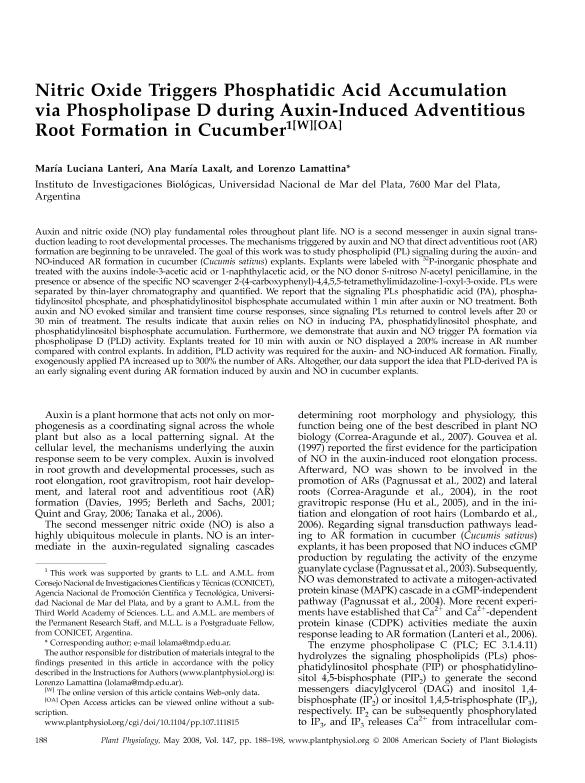Mostrar el registro sencillo del ítem
dc.contributor.author
Lanteri, Maria Luciana

dc.contributor.author
Laxalt, Ana Maria

dc.contributor.author
Lamattina, Lorenzo

dc.date.available
2021-06-16T13:03:08Z
dc.date.issued
2008-07
dc.identifier.citation
Lanteri, Maria Luciana; Laxalt, Ana Maria; Lamattina, Lorenzo; Nitric oxide triggers phosphatidic acid accumulation via phospholipase D during auxin-induced adventitious root formation in cucumber; American Society of Plant Biologist; Plant Physiology; 147; 1; 7-2008; 188-198
dc.identifier.issn
0032-0889
dc.identifier.uri
http://hdl.handle.net/11336/133981
dc.description.abstract
Auxin and nitric oxide (NO) play fundamental roles throughout plant life. NO is a second messenger in auxin signal transductionleading to root developmental processes. The mechanisms triggered by auxin and NO that direct adventitious root (AR)formation are beginning to be unraveled. The goal of this work was to study phospholipid (PL) signaling during the auxin- andNO-induced AR formation in cucumber (Cucumis sativus) explants. Explants were labeled with 32P-inorganic phosphate andtreated with the auxins indole-3-acetic acid or 1-naphthylacetic acid, or the NO donor S-nitroso N-acetyl penicillamine, in thepresence or absence of the specific NO scavenger 2-(4-carboxyphenyl)-4,4,5,5-tetramethylimidazoline-1-oxyl-3-oxide. PLs wereseparated by thin-layer chromatography and quantified. We report that the signaling PLs phosphatidic acid (PA), phosphatidylinositolphosphate, and phosphatidylinositol bisphosphate accumulated within 1 min after auxin or NO treatment. Bothauxin and NO evoked similar and transient time course responses, since signaling PLs returned to control levels after 20 or30 min of treatment. The results indicate that auxin relies on NO in inducing PA, phosphatidylinositol phosphate, andphosphatidylinositol bisphosphate accumulation. Furthermore, we demonstrate that auxin and NO trigger PA formation viaphospholipase D (PLD) activity. Explants treated for 10 min with auxin or NO displayed a 200% increase in AR numbercompared with control explants. In addition, PLD activity was required for the auxin- and NO-induced AR formation. Finally,exogenously applied PA increased up to 300% the number of ARs. Altogether, our data support the idea that PLD-derived PA isan early signaling event during AR formation induced by auxin and NO in cucumber explants.
dc.format
application/pdf
dc.language.iso
eng
dc.publisher
American Society of Plant Biologist

dc.rights
info:eu-repo/semantics/openAccess
dc.rights.uri
https://creativecommons.org/licenses/by-nc-sa/2.5/ar/
dc.subject
adventitious root
dc.subject
phosphatidic acid
dc.subject
nitric oxide
dc.subject.classification
Bioquímica y Biología Molecular

dc.subject.classification
Ciencias Biológicas

dc.subject.classification
CIENCIAS NATURALES Y EXACTAS

dc.title
Nitric oxide triggers phosphatidic acid accumulation via phospholipase D during auxin-induced adventitious root formation in cucumber
dc.type
info:eu-repo/semantics/article
dc.type
info:ar-repo/semantics/artículo
dc.type
info:eu-repo/semantics/publishedVersion
dc.date.updated
2021-02-18T15:47:51Z
dc.journal.volume
147
dc.journal.number
1
dc.journal.pagination
188-198
dc.journal.pais
Estados Unidos

dc.description.fil
Fil: Lanteri, Maria Luciana. Consejo Nacional de Investigaciones Científicas y Técnicas. Centro Científico Tecnológico Conicet - Mar del Plata. Instituto de Investigaciones Biológicas. Universidad Nacional de Mar del Plata. Facultad de Ciencias Exactas y Naturales. Instituto de Investigaciones Biológicas; Argentina
dc.description.fil
Fil: Laxalt, Ana Maria. Consejo Nacional de Investigaciones Científicas y Técnicas. Centro Científico Tecnológico Conicet - Mar del Plata. Instituto de Investigaciones Biológicas. Universidad Nacional de Mar del Plata. Facultad de Ciencias Exactas y Naturales. Instituto de Investigaciones Biológicas; Argentina
dc.description.fil
Fil: Lamattina, Lorenzo. Consejo Nacional de Investigaciones Científicas y Técnicas. Centro Científico Tecnológico Conicet - Mar del Plata. Instituto de Investigaciones Biológicas. Universidad Nacional de Mar del Plata. Facultad de Ciencias Exactas y Naturales. Instituto de Investigaciones Biológicas; Argentina
dc.journal.title
Plant Physiology

dc.relation.alternativeid
info:eu-repo/semantics/altIdentifier/doi/http://dx.doi.org/10.1104/pp.107.111815
dc.relation.alternativeid
info:eu-repo/semantics/altIdentifier/url/https://academic.oup.com/plphys/article/147/1/188/6107430
Archivos asociados
